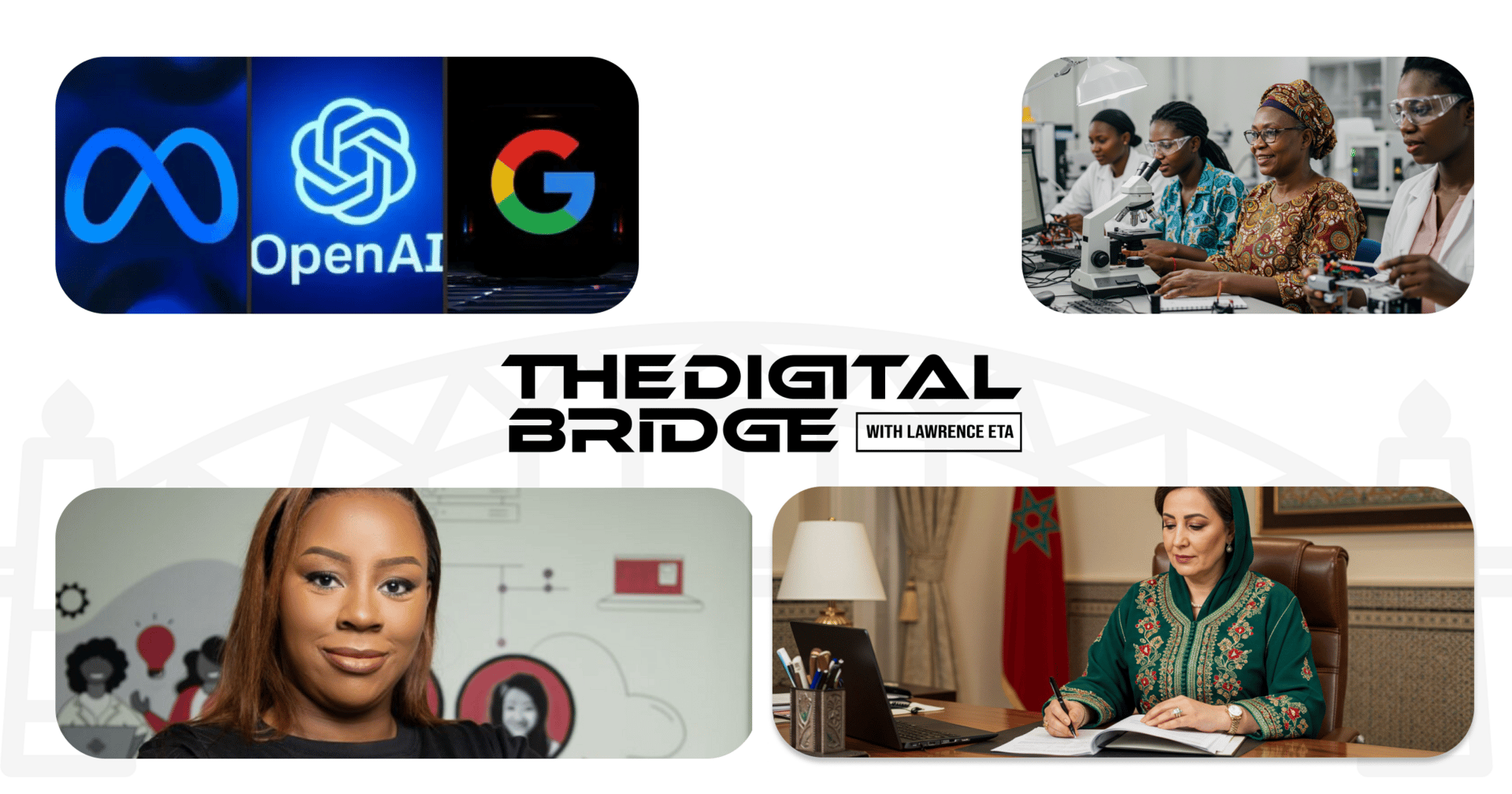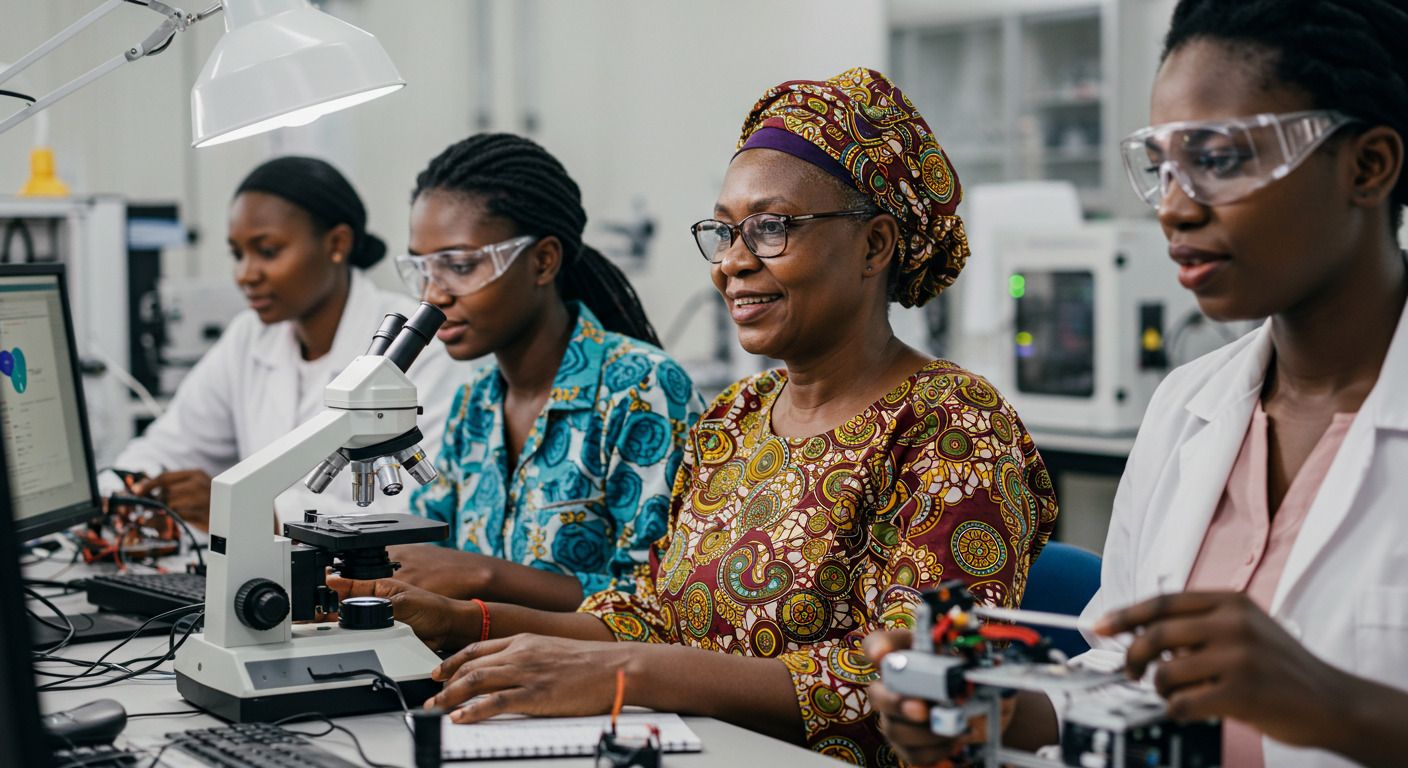- The Digital Bridge with Lawrence Eta
- Posts
- From Sandboxes to STEM: Building Systems for Resilient Growth
From Sandboxes to STEM: Building Systems for Resilient Growth
Tech News, Global Digital Transformation, Thought Leadership and Current Trends


NAVIGATING A NEW DIGITAL LANDSCAPE
The past week underscored a critical truth: technology does not evolve in isolation, it advances within the systems we design around it. From new policy experiments in the United States to Africa’s growing STEM talent pool and Morocco’s push for pay equity, the conversations all point to a single theme, the digital economy of tomorrow will be defined by the choices we make today.
In this edition, we explore how governments, industries, and communities are shaping that future. The U.S. is testing regulatory sandboxes for AI, Africa is producing more women STEM graduates than any other region yet still battling barriers to leadership, and Morocco is confronting a persistent wage gap in its private sector. Alongside these shifts, leaders like Zandile Mkwanazi are showing what inclusive innovation looks like in practice.
In today’s edition, let’s explore the week’s most telling moves:
U.S. AI SANDBOX: A NEW REGULATORY EXPERIMENT
AFRICA’S WOMEN IN STEM: TALENT PIPELINE VS. TECH REALITY
MOROCCO’S PRIVATE SECTOR: A GENDER PAY GAP OF 42.8%
TECH SPOTLIGHT: ZANDILE MKWANAZI
Built for Managers, Not Engineers
AI isn’t just for developers. The AI Report gives business leaders daily, practical insights you can apply to ops, sales, marketing, and strategy.
No tech jargon. No wasted time. Just actionable tools to help you lead smarter.
Start where it counts.
U.S. AI SANDBOX:
A NEW REGULATORY EXPERIMENT

The debate over how to regulate artificial intelligence in the United States reached a new stage this week with Senator Ted Cruz introducing a proposal for an AI “sandbox.” The bill would allow AI companies to apply for two-year exemptions from certain federal rules, giving them space to experiment with new technologies while outlining risk mitigation strategies.
The proposal comes at a time when U.S. lawmakers are weighing how to balance innovation with oversight, particularly as competition with China intensifies. Cruz, who chairs the Senate Commerce Committee, framed the sandbox as a tool to lower regulatory hurdles without removing accountability, noting that AI companies would still be required to comply with existing laws outside the scope of the exemptions.
The plan has drawn both support and criticism. Technology firms including O
have pressed for fewer regulatory barriers, and the White House has already committed to gathering public comment on what rules most obstruct innovation. At the same time, consumer advocacy groups argue that the proposal would treat citizens as test subjects, raising particular concern over provisions that give the White House Office of Science and Technology Policy authority to override agency denials of sandbox applications.
Beyond federal-level debate, the sandbox bill leaves unresolved the tension between state and national regulation. Several states have already enacted their own AI laws. California bans unauthorized deepfakes in political advertising and requires transparency when healthcare providers use AI in patient interactions. Colorado passed legislation to curb algorithmic bias in employment, housing, and financial services, with implementation now set for 2026. These measures reflect growing public concern about fairness, privacy, and accountability in AI use, and stand in contrast to industry calls for a pause or rollback of state-level regulation.
The broader backdrop is one of regulatory divergence. While the United States is considering exemptions and flexibility, Europe is pressing forward with the EU AI Act, one of the world’s most comprehensive frameworks. Meanwhile, in Africa, governments are beginning to align around the African Union’s Data Policy Framework, a foundation for sovereignty and trust in the digital age.
The stakes are high. A U.S. regulatory sandbox could accelerate innovation, but it also risks undercutting public trust if safety concerns are not adequately addressed. For regions still shaping their AI policies, the lesson is clear: the path to competitiveness cannot come at the cost of accountability. Building resilient, inclusive systems will be essential to ensure that the benefits of AI are broadly shared and that governance keeps pace with innovation.
AFRICA’S WOMEN IN STEM:
TALENT PIPELINE VS. TECH REALITY

Africa holds a global distinction: nearly 47% of STEM graduates are women, the highest percentage worldwide. By comparison, Europe produces 42%, Asia and South America 41%, and North America 39%. Yet despite this strength at the education level, the continent faces a sharp drop-off when it comes to translating qualifications into leadership roles, workforce participation, and access to capital.
The McKinsey report underscores a paradox. On paper, Africa has built the strongest foundation for female participation in science and technology. In practice, women occupy only 23–30% of technology roles in sub-Saharan Africa, just slightly above the global average. Representation plummets further at the top: fewer than 12% of leadership positions in African tech firms are held by women, and fewer than 3% of billion-dollar companies feature a woman in a senior tech leadership role.
The gap is even starker in financing. In 2024, startups founded by women captured only 1% of total technology funding, while male-founded companies absorbed 94%. Mixed-gender teams secured the remaining 5%. This imbalance not only limits entrepreneurship, but also restricts innovation that could be driven by women-led enterprises.
National performance varies widely. South Africa (17%) and Nigeria (20%) show comparatively stronger representation of women in C-suite tech roles, while Egypt (4%), Tanzania (9%), and Namibia (10%) lag significantly. Several countries, including Botswana, Malawi, Seychelles, Sudan, and Uganda, report no women in top technology roles within listed firms.
McKinsey identifies three critical “leak points” where female representation deteriorates:
Education to Employment: Nearly half of STEM graduates are women, but far fewer transition into technology roles.
Career Progression: Women face advancement and retention barriers, often leading to attrition.
Access to Funding: Women founders receive a negligible share of venture investment compared to men.
The report calls for targeted interventions:
Recruitment strategies linked to universities, internships, and apprenticeships.
Inclusive workplace policies including mentorship, anti-bias training, childcare support, and return-to-work programs.
Dedicated investment financing with grants, mentoring, and awareness programs to prepare women entrepreneurs for capital access.
Harnessing the potential of Africa’s women in STEM is not only about equity; it is also about competitiveness. Mobilizing nearly half of the continent’s STEM talent pool could significantly narrow the digital skills gap, drive innovation, and ensure the economic dividends of the digital revolution are shared broadly.
For Africa, the choice is clear: turning educational success into workforce leadership will determine whether the continent’s digital transformation is inclusive, resilient, and sustainable.
AFRICA’S WOMEN IN STEM:
A GENDER PAY GAP OF 42.8%

A new report has put a spotlight on the scale of gender-based wage inequality in Morocco’s private sector. According to “Égalité Pro, STOP aux ECARTS” by Maria Charaf, women in the private sector earn 42.8% less than men, with the national average gender pay gap at 23%. Put differently, women effectively work three months of the year without pay.
The research, drawing on official data from Morocco’s High Commission for Planning (HCP), highlights stark disparities across roles. In 2019, men in the private sector earned a median monthly salary of 3,360 MAD ($336), compared to 2,800 MAD ($280) for women. Among senior executives and managers, the gap was 38.1% (9,000 MAD vs. 12,400 MAD). Middle managers faced an almost identical 38.4% gap, while even non-agricultural laborers earned 30% less than their male counterparts.
The HCP’s analysis attributes 91% of this disparity to gender discrimination, with only 9% explained by differences in education or professional training. The public sector tells a different story, where the gap is much smaller at 2.4% (8,300 MAD for women compared to 8,500 MAD for men).
Progress on representation has been uneven. Women occupied just 23.5% of responsibility posts in public administration in 2021, improving to 28% in 2022. In corporate governance, the introduction of Law No. 19-20 mandated gender quotas for listed companies, requiring boards to have at least 30% female representation by 2024 and 40% by 2027. By the end of 2023, women held 23.2% of board seats, with 31% of boards already meeting the 30% requirement.
The guide lays out practical tools for organizations: audit grids, compliance checklists, salary gap assessment matrices, and harassment prevention procedures. It recommends a three-step approach, diagnose disparities using HR data, create a realistic action plan with preventive and corrective measures, and publish annual results transparently.
It also stresses that gender equality is an economic necessity as well as a social imperative. The World Bank estimates that closing the gender employment gap could increase Morocco’s GDP per capita by nearly 40%. The report points to international models such as Iceland’s Equal Pay Standard, France’s Professional Equality Index, and Canada’s Federal Pay Equity Act as examples that Morocco could adapt.
For sustainable progress, the guide calls for greater transparency in reporting, stronger labor inspection, effective collective bargaining, planned salary adjustments, and concrete action to dismantle the glass ceiling that continues to block women’s advancement in Morocco’s private sector.
TECH SPOTLIGHT:
ZANDILE MKWANAZI

This month we highlight Zandile Mkwanazi, CEO and co-founder of GirlCode, a South African non-profit dedicated to closing the gender gap in technology.
Founded in 2014, GirlCode has grown into one of Africa’s leading organizations training women in coding, data science, and software engineering. Under Mkwanazi’s leadership, the program has reached thousands of young women through hackathons, workshops, and bootcamps building pathways into careers that remain male-dominated across the continent.
Her vision goes beyond skills training. GirlCode also addresses structural barriers, from access to mentorship to the lack of female role models in leadership. Mkwanazi has argued that solving Africa’s digital skills gap requires not just more coders, but more inclusive ecosystems where women can thrive as founders, engineers, and decision-makers.
In a year when Africa leads the world in the percentage of women STEM graduates, leaders like Mkwanazi remind us that education is only the starting point. To fully unlock potential, women need equal access to jobs, capital, and leadership roles. Initiatives like GirlCode are making this future possible, one training program and one empowered graduate at a time.
Building Inclusive Frameworks for the Digital Future
From Washington’s regulatory experiments to Africa’s untapped STEM potential and Morocco’s urgent push for pay equity, the message is consistent: the digital future will be defined by the frameworks we build today.
AI sandboxes show how governments wrestle with innovation and accountability. Africa’s women in STEM highlight the promise of talent pipelines and the risks of structural barriers. Morocco’s pay gap illustrates how discrimination still limits growth, even when the skills exist. And leaders like Zandile Mkwanazi remind us that inclusion is not a side project but the foundation of resilience.
For economies and societies everywhere, the next decade will be shaped by whether we treat innovation as a shared asset or as a privilege of the few. Building resilient, inclusive systems will not only drive competitiveness, but also ensure that technology remains a force for prosperity and equity. Keep up with us:
Twitter: Click here
Facebook: Click here
Instagram: Click here
LinkedIn: Click here
Enjoyed this newsletter? Share it with friends and help us spread the word!
Until next time, happy reading!
SPEAKERS REEL
Lawrence Eta: A Global Voice on Digital & AI
From TEDx to the Leap Tech Summit, from boardrooms to global stages, Lawrence Eta has built a reputation as a speaker who doesn’t just talk about the future, he brings it to life.
As a Global Digital & AI Advisor, Lawrence delivers powerful insight on:
Digital transformation and its real business impact
The role of AI in shaping tomorrow’s economy
How leaders can bridge cultural and technological worlds
This speaker’s reel captures that clarity, energy, and authority; showcasing why organizations across the world trust him to guide conversations on the future of business and technology.
JOIN THE COMMUNITY
The Bridging Worlds Book
Discover Bridging Worlds, a thought-provoking book on technology, leadership, and public service. Explore Lawrence’s insights on how technology is reshaping the landscape and the core principles of effective leadership in the digital age.
Order your copy today and explore the future of leadership and technology.
SHARE YOUR THOUGHTS
We value your feedback!
Your thoughts and opinions help us improve our newsletter. Please take a moment to let us know what you think.
How would you rate this newsletter? |

Reply